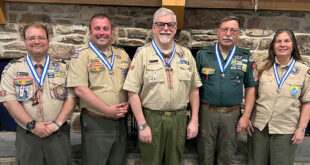This article originally appeared on the BSA’s Bryan on Scouting blog on April 6, 2015
The BSA’s Youth Protection guidelines prohibit one-one-one contact between adults and youth members. That much you know.
But in a world where an increasing number of our communications are digital, how does that rule apply?
That was the question from Matthew S., a Scouter who contacted me recently. Matthew writes:
Bryan,
We’re looking to implement Eagle coaches in our troop, and one of the ways we’re looking to offer contact with the candidates is through text messages. Is text messaging considered one-on-one contact? If so, is there another way to do it? Not every person has the ability to use group messaging, but more and more boys are communicating via text instead of email lately.
Thank you,
Matthew S.
Great question, Matthew. I’m sure you’re not the only Scout leader who’s wondering this.
So I asked the expert: Michael Johnson, Youth Protection Director for the Boy Scouts of America.
He writes:
The expert responds: One-on-one contact in cyberspace
Great question and thank you for considering Youth Protection policies as you work to create a fun program. Scouting’s Barriers to Abuse apply in cyberspace:
Youth Protection policies extend into cyberspace. There should be no one-on-one online or digital activities (games, social media, etc.) or electronic communications. Leaders should include or copy a parent or another leader in all online communications, ensuring no one-on-one contact exists in text, social media or other forms of online or digital communication.
Our partners at the National Center for Missing and Exploited Children (NCMEC) NetSmartz Workshopprogram advise us child predators are knowledgeable about BSA’s polices regarding two-deep leadership and no one-on-one contact. As a result, they seek interactions with youth in cyberspace where youth interact with each other and are usually unsupervised by parents (i.e., gaming, chat rooms, etc.)
As a safety precaution to protect youth and leaders, we require all interactions (e.g., texting, email, instant messaging, etc.) to be copied to a parent or other registered leader. While we understand that this may present a challenge to some, we feel that safe interactions are of prime concern.
As a reminder, all leaders should be providing the Cyber Chip program to Scouting youth so that they may be better able to recognize, respond to and report inappropriate activity to the CyberTipline (1-800-THE-LOST (843-5678)) and local Scout executive. To help families and volunteers keep youth safe while online, the BSA introduced the Cyber Chip.
We also recommend that Eagle Scout coaches who are selected by units become registered. By registering these key leaders in the growth of our Scouts, they would then be properly vetted through background checks and would be required to take Youth Protection training. What better way to ensure the safety of all our youth, than by asking all adults involved with the advancement of these Scouts to be a part of our safety programs?
NCMEC suggests that leaders and parents of Scouts check out the following NetSmartz website and tip sheet that provide helpful information on safe cell phone usage:
http://www.netsmartz.org/CellPhones
http://cdn.netsmartz.org/tipsheets/smartphone_safety.pdf
TIP: How Using Scoutbook’s Communications Tools Can Help
If your unit uses Scoutbook, adult leaders can use the communications features within Scoutbook to send text or email messages to a Scout, with that Scout’s parents being automatically copied on any message. Parents are able to determine if their Scout can receive text or email messages through Scoutbook.
More information regarding Scoutbook’s communications tools is available at https://help.scoutbook.com/article-categories/communication/.
 ARCHIVE – New Birth of Freedom Council, BSA Website for the New Birth of Freedom Council, BSA
ARCHIVE – New Birth of Freedom Council, BSA Website for the New Birth of Freedom Council, BSA


